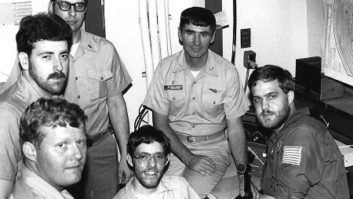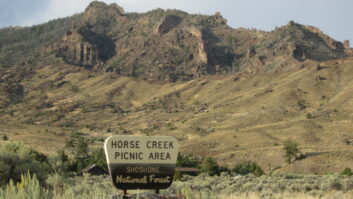When a college decides to sell the FCC license of its student radio station and move to an all-online radio experience, what’s the impact on its students and its learning program?
I set out to find the answer to this question by talking with educators who have gone through this experience.

A screenshot shows the primary online presence for KUSF. First, note that not all colleges that have decided to give up their student station’s FCC license had an educational program in place that tied to the student radio station.
Vanderbilt’s WRVU(FM) is an example. I spoke with the communications department chair Bonnie Dow and learned that there was no pedagogy —the method and practice of teaching — tied to the student radio station. WRVU also recently announced that it would be getting a low-power FM license and would be returning to the air in Nashville.
Another example is Rice University, which saw its student-run 50,000-watt FM license sold by the university to remain an online streaming radio station, later leasing another Houston radio station’s HD2 signal. Will Robedee, the station’s GM, told me, “A lot of people thought the radio station went away entirely.” KTRU had been streaming its programming online since 1999, but leaving the FM analog band in 2011 was a major blow. KTRU returned to the FM band with a 100-watt LPFM license at 96.1 on College Radio Day this fall, and there’s a lot of excitement from both the students and the community about its return.
STUDENT LEARNING IMPACT
When I called Dr. Dorothy Kidd, chair of media studies at the University of San Francisco, I would finally get some answers to the question of the pedagogical impact of an institution terminating its student radio station FCC license in favor of a streaming-only station.
KUSF sold its FCC license in 2011, and four years later Kidd shared how the university navigated the change. First, the selling of the license set off a major firestorm in the city. Kidd told me that while she had fought hard to save the license, after about two years, reality set in. It was decided that, for the sake of the students, the program needed to rethink things.

The station also utilizes the online platform Bandcamp. She began to focus more on how the online radio station would be operated and brought it in closer to the department of media studies. A new professor was hired to teach podcasting and other hybrid media skills that would complement the student-run online station.
“We decided we had to take the reality we were going to lose the FM license and basically had to go into the online environment and figure out how it would be positive for students and how we could support that with skill development,” said Kidd.
But what ultimately changed? The station now has more student participation but community engagement has dropped dramatically.
“It’s a big loss in a few different ways,” said Kidd, “in that KUSF really was the platform for San Francisco’s vibrant arts community, and KUSF provided the glue that brought this community together. We have lost the local community emphasis of KUSF.”
Not having an analog FM signal has cut into this community engagement and involvement with the students. They may not have a clue what’s going on, even though it’s only five blocks away. While Kidd says they are working hard to rebuild this aspect of the program, not just those inside the academy were upset about the FM license being sold; the community was just as upset. Healing those feelings and emotions is taking time.
“How this impacts pedagogy is that today’s students, ages 18–22, are really into mediated communications but they really don’t know much about what’s happening on the ground,” Kidd said.
KUSF has more than 200 students involved in the online radio station, but it has a much smaller listenership as a streaming station than the 20,000+ it enjoyed over the FM band. And this brings up another interesting problem with a streaming station. If KUSF builds its online audience to the size of its former FM listenership, its current equipment could not handle that number of connections; the station would need new technology to handle the online listenership.
Can students learn everything they need to know about radio via a streaming student station versus an FM or LPFM station? From a technical skills standpoint the answer is probably yes, unless the student plans an engineering career, where air chains remain highly specialized. But they will not experience the same connection with their local community with a streaming-only student radio station experience.
In the end, whether a college has a media program tied to the student radio station or not, the loss of an FM license in every case disconnects the station from its community, even though it can still be heard via the Internet.
That’s something all broadcasters need to remember.
Dick Taylor is a Certified Radio and Digital Marketing Consultant and assistant professor of broadcasting at Western Kentucky University in Bowling Green, Ky. He joined the faculty of its School of Journalism and Broadcasting after a 42-year career in radio. He is director of the KBA WKU Radio Talent Institute and is on the board of the New Jersey Broadcasters Association.









